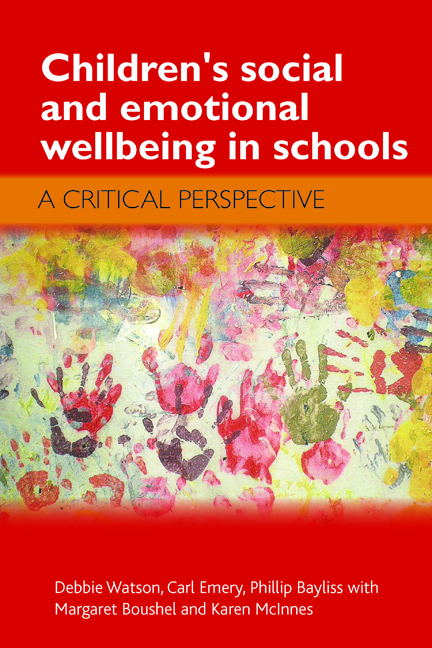Chapter 1 - Introduction
Published online by Cambridge University Press: 01 September 2022
Summary
Wellbeing as a concept has crept into policy agendas and practice in a range of settings, notably in health care and in regards to work and employment. Increasingly, attention is focused on child wellbeing with reports of increased mental and emotional health needs in children, bullying in schools, and major reports such as the United Nations Children's Fund report on child wellbeing in rich countries (UNICEF, 2007), which suggested children and young people were less satisfied with their lives, less happy, have a poor quality of life and report a lower subjective wellbeing. Such reports have resulted in the almost uncritical acceptance of the need to improve wellbeing among school-aged children in the UK through the Every Child Matters agenda (DfES, 2004a), National Healthy Schools Standard Promoting Emotional Health and Wellbeing (DFEE, 2005), and the Happy, Safe and Achieving their Potential guidance in Scotland (SE, 2004), with parallel debates occurring elsewhere in the world and led by organisations such as the World Health Organization (WHO, 1999).
Why social and emotional wellbeing?
Although this book explores a range of wellbeing perspectives, the emphasis is on what we have termed ‘social and emotional wellbeing’ (SEWB) in education. SEWB is an umbrella term that encompasses the wide range of concepts, skills, dispositions and attitudes infused within UK education policy and promoted through programmes such as Social and Emotional Aspects of Learning (SEAL), Promoting Alternative Thinking Strategies (PATHS), Second Step, Creating Confident Kids, the UK Resilience Programme, and Getting Connected. The term SEWB includes both programmes focused on positive models emphasising and promoting social and emotional wellbeing, and deficit or negative models that seek to repair or develop responses to socially problematic issues such as depression, anxiety and anti-social behaviour. The National Institute for Clinical Excellence (NICE) stated that SEWB encompasses:
• happiness, confidence and not feeling depressed (emotional wellbeing);
• a feeling of autonomy and control over one's life, problem-solving skills, resilience, attentiveness and a sense of involvement with others (psychological wellbeing); and
• the ability to have good relationships with others and to avoid disruptive behaviour, delinquency, violence or bullying (social wellbeing).
As SEWB has developed across the UK, practice and policy terminology has morphed. Many early programmes were launched under the banner of ‘Emotional Intelligence’ or ‘Emotional Literacy’. By the mid-2000s, this had become Social and Emotional Learning and, in particular, SEAL (the Department for Children, Schools and Families’ schools-based programme).
- Type
- Chapter
- Information
- Children's Social and Emotional Wellbeing in SchoolsA Critical Perspective, pp. 1 - 14Publisher: Bristol University PressPrint publication year: 2012



